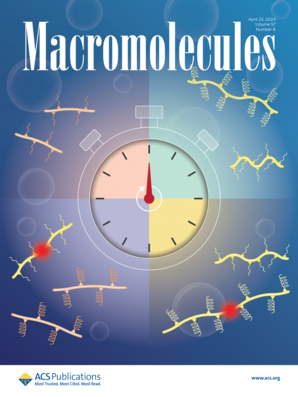Deuteration Effects on the Physical and Optoelectronic Properties of Donor–Acceptor Conjugated Polymers
IF 5.1
1区 化学
Q1 POLYMER SCIENCE
引用次数: 0
Abstract
The significant differences in scattering cross sections between deuterium and protium are unique to neutron scattering techniques and have been a long-standing area of interest within the neutron scattering community. Researchers have explored selective deuteration to manipulate scattering contrast in soft matter systems, leading to the widespread use of deuterium labeling in materials development. As deuteration changes the atomic mass, it alters physical properties such as molecular volume, polarizability, and polarity, which in turn may affect noncovalent interactions and crystal ordering. Despite previous studies, there remains a limited understanding of how deuteration impacts donor–acceptor (DA) conjugated polymers. To address this, we synthesized deuterated DPP polymers and systematically investigated the effects of side-chain deuteration on their thermal stability, crystal packing, morphology, and optoelectronic properties. We found that deuteration increased the melting and crystallization temperatures of DPP polymers, although it did not significantly alter their morphology, molecular packing, or charge mobility. These properties were assessed by using atomic force microscopy (AFM), X-ray scattering, and thin-film transistor device measurements, respectively, for DPP polymers. Our work shows that deuterium labeling could be a powerful method for controlling scattering length density, enabling neutrons to study the structure and dynamics of conjugated polymers without impacting their electronic performance.

氘化对施主-受体共轭聚合物物理和光电性能的影响
氘和质子在散射截面上的显著差异是中子散射技术所特有的,并且一直是中子散射界长期关注的领域。研究人员已经探索了选择性氘化来操纵软物质系统中的散射对比,导致氘标记在材料开发中的广泛使用。由于氘化作用改变了原子质量,它改变了物理性质,如分子体积、极化率和极性,这反过来可能影响非共价相互作用和晶体有序。尽管以前的研究,仍然有一个有限的了解如何氘化影响供体-受体(DA)共轭聚合物。为了解决这个问题,我们合成了氘化DPP聚合物,并系统地研究了侧链氘化对其热稳定性、晶体堆积、形貌和光电子性能的影响。我们发现氘化增加了DPP聚合物的熔融和结晶温度,尽管它没有显著改变它们的形态、分子堆积或电荷迁移率。这些特性分别通过原子力显微镜(AFM)、x射线散射和薄膜晶体管器件测量对DPP聚合物进行了评估。我们的工作表明,氘标记可以成为控制散射长度密度的有力方法,使中子能够在不影响其电子性能的情况下研究共轭聚合物的结构和动力学。
本文章由计算机程序翻译,如有差异,请以英文原文为准。
求助全文
约1分钟内获得全文
求助全文
来源期刊

Macromolecules
工程技术-高分子科学
CiteScore
9.30
自引率
16.40%
发文量
942
审稿时长
2 months
期刊介绍:
Macromolecules publishes original, fundamental, and impactful research on all aspects of polymer science. Topics of interest include synthesis (e.g., controlled polymerizations, polymerization catalysis, post polymerization modification, new monomer structures and polymer architectures, and polymerization mechanisms/kinetics analysis); phase behavior, thermodynamics, dynamic, and ordering/disordering phenomena (e.g., self-assembly, gelation, crystallization, solution/melt/solid-state characteristics); structure and properties (e.g., mechanical and rheological properties, surface/interfacial characteristics, electronic and transport properties); new state of the art characterization (e.g., spectroscopy, scattering, microscopy, rheology), simulation (e.g., Monte Carlo, molecular dynamics, multi-scale/coarse-grained modeling), and theoretical methods. Renewable/sustainable polymers, polymer networks, responsive polymers, electro-, magneto- and opto-active macromolecules, inorganic polymers, charge-transporting polymers (ion-containing, semiconducting, and conducting), nanostructured polymers, and polymer composites are also of interest. Typical papers published in Macromolecules showcase important and innovative concepts, experimental methods/observations, and theoretical/computational approaches that demonstrate a fundamental advance in the understanding of polymers.
 求助内容:
求助内容: 应助结果提醒方式:
应助结果提醒方式:


